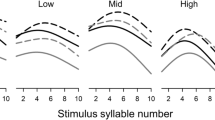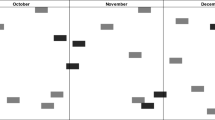Synopsis
Reproductive events tend to be synchronized in natural populations ofXiphophorus variatus. Males physically resembling one another tend to mature at the same rate and time. This coordinate development has also been seen in the laboratory. We hypothesize that juveniles resembling each other experience fewer aggressive responses from males than do juveniles without ‘look-alikes’, because of habituation of aggression. This would decrease social inhibition and permit their synchronous development.
Females have an ovarian cycle. In the laboratory, crowding stress causes a suspension of breeding while a return to uncrowded conditions permits its resumption. Females released simultaneously from crowding tend to be synchronized in subsequent broods, although the synchrony deteriorates with time. Synchronizing events are shown to occur in natural populations.
The consequences of reproductive synchrony in males and females are briefly discussed.
Similar content being viewed by others

References cited
Borowsky, R.L. 1973a, Social control of adult size in males ofXiphophorus variatus. Nature 245: 332–335.
Borowsky, R.L. 1973b. Relative size and the development of fin coloration inXiphophorus variatus. Physiol. Zool. 46: 22–28.
Borowsky, R.L. 1978a. The tailspot polymorphism ofXiphophorus (Pisces: Poeciliidae). Evol. 32: 886–893.
Borowsky, R.L. 1978b, Social inhibition of maturation in natural populations ofXiphophorus variatus (Pisces: Poeciliidae). Science 201: 933–935.
Borowsky, R.L. & K.D. Kallman. 1976. Patterns of mating in natural populations ofXiphophorus (Pisces: Poeciliidae). I:X maculatus from Belize and Mexico, Evol. 30: 693–706.
Clayton, E. & R.A. Hinde. 1968. The habituation and recovery of aggressive display inBetta splendans. Behaviour 30: 96–106.
Constantz, G.D. 1979. Life history patterns of a livebearing fish in contrasting environments, Oecol. 40: 189–201.
Darnell, R.M. 1962, Fishes of the Rio Tamesi and related coastal lagoons in East-Central Mexico. Publ. Inst. Mar. Sci. (Port Aransas, Texas) 8: 299–365.
Endler, J.A. 1978. A predator's view of animal color patterns, Evol. Biol. 11: 319–364.
Farr, J.A. 1975, The role of predation in the evolution of social behavior of natural populations of the guppy,Poecilia reticulata (Pisces: Poeciliidae). Evol. 29: 151–158.
Gallagher, J.E., M.J. Herz & H.V. Peeke. 1972, Habituation of aggression: the effects of visual social stimuli on behavior between adjacently territorial convinct cichlids (Cichlasoma nigrofasciatum). Behav. Biol. 7: 359–368.
Gandolfi, G. 1971, Sexual selection in relation to the social status of males inPoecilia reticulata (Teleostei: Poeciliidae). Boll. Zool. 38: 35–48.
Kallman, K.D. 1975. The platyfish, Xiphophorus maculatus, pp. 81–132, In: R.C. King (ed.) Handbook of Genetics, Vol. 4. Plenum Press, New York.
Kallman, K.D. & M.P. Schreibman. 1973, A sex-linked gene controlling gonadotrop differentiation and its significance in determining the age of sexual maturation and size of the platyfish.Xiphophorus maculatus. Gen. Comp. Endocrinol. 21: 287–304.
Liley, N.R. 1966. Ethological isolating mechanisms in four sympatric species of poeciliid fishes. Behaviour Suppl. 13: 1–197.
Maglio, V.J. & D.E. Rosen. 1969. Changing preference for substrate color by reproductively active mosquitofish.Gambusia affinis (Baird and Girard) (Poeciliidae. Atheriniformes). Amer. Mus. Novit. 2397: 1–37.
Scrimshaw, N.S. 1944. Embryonic growth in the viviparous poeciliid.Heterandria formosa. Biol. Bull, 87: 37–51.
Scrimshaw, N.S. 1946. Egg size in poeciliid fishes. Copeia 1946: 20–23.
Siciliano, M.J. 1972. Evidence for a spontaneous ovarian cycle in fishes of the genusXiphophorus. Biol. Bull. 142: 480–488.
Sohn, J.J. 1977a. Socially induced inhibition of genetically determined maturation in the platyfish,Xiphophorus maculatus. Science 195: 199–201.
Sohn, J.J. 1977b. The consequences of predation and competition upon the demography ofGambusia manni (Pisces: Poeciliidae). Copeia 1977: 224–227.
Stearns, S.C. 1977. The evolution of life history traits: a critique of the theory and a review of the data. Ann. Rev. Ecol. Syst. 8: 145–171.
Stearns, S.C. 1978. Interpopulation differences in reproductive traits ofNeoheterandria tridentiger (Pisces: Poeciliidae) in Panama. Copeia 1978: 188–190.
Tavolga, W.N. 1949. Embryonic development of the platyfish (Platypoecilius) and swordtail (Xiphophorus) and their hybrid. Bull. Amer. Mus. Nat. Hist. 94: 165–229.
Thibault, R. & R.J. Schultz. 1978. Reproductive adaptations among viviparous fishes (Cyprinodontiformes: Poeciliidae). Evol. 32: 320–333.
Author information
Authors and Affiliations
Rights and permissions
About this article
Cite this article
Borowsky, R., Diffley, J. Synchronized maturation and breeding in natural populations ofXiphophorus variatus (Poeciliidae). Environ Biol Fish 6, 49–58 (1981). https://doi.org/10.1007/BF00001799
Received:
Accepted:
Issue Date:
DOI: https://doi.org/10.1007/BF00001799



